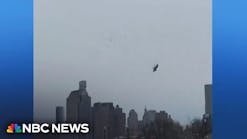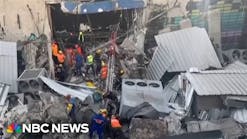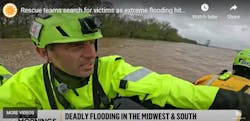20 Years Later, New Investigation May Yield New Findings Into Cause
A hazardous materials explosion that occurred 20 years ago this month claimed the lives of six Kansas City, MO, firefighters. A nine-year investigation determined that the fire that caused the explosion was deliberately set and five people were convicted of the crime. New research, however, has led to the case being reopened with the possibility of those convictions being overturned.
On Nov. 29, 1988, at 3:40 A.M., the Kansas City Fire Department received a call for a fire at a highway construction site. The fire was reported by a security guard at the site to be in a small pickup truck, but in the background another security guard could be heard saying "the explosives are on fire." Pumper 41 was dispatched to the site with a captain and two firefighters (in Kansas City, a fire apparatus with a pump is called a pumper). Dispatch cautioned Pumper 41 that there may be explosives at the site.
Pumper 41 arrived on scene at 3:46 and found two separate fires burning. A second pumper company was requested. Pumper 41 also requested that dispatch warn Pumper 30 of the potential for explosives at the site. Pumper 30 arrived on scene at 3:52. Four of the six firefighters on Pumpers 30 and 41, including both officers, had received hazardous materials training through National Fire Academy (NFA) field courses. Four had completed the NFA course "Recognizing and Identifying Hazardous Materials." One of the firefighters and one company officer had also taken the NFA field course "Hazardous Materials Incident Analysis." According to the U.S. Fire Administration (USFA) Technical Report on the incident, "Both courses downplay the potential explosiveness of the type of blasting agent involved in this incident." They go on to say that "this impression needs to be corrected."
Because there were two separate fires at the site, the crew from Pumper 30 suspected arson and requested that the police be dispatched to the scene. Approximately five minutes after the arrival of Pumper 30, Pumper 41 requested a battalion chief be sent "emergency" to the scene. There was a great deal of confusion at the site as to whether there were explosives on site or whether the explosives were involved in the fires. Following the extinguishment of the pickup fire, Pumper 41 proceeded to the other fires to assist Pumper 30. A truck, a trailer and a compressor were on fire at 4:02. None of the vehicles or trailer appeared to be marked. There were no indications that the firefighters suspected any explosives were involved in the fires they were attempting to extinguish.
As it turns out, the "trailer" that was on fire actually was an explosives magazine. At 4:04, Pumper 41 contacted Battalion Chief 107, who had been dispatched to the incident. Pumper 41 indicated that "Apparently, this thing's already blowed up, Chief. He's got magnesium or something burning up here." At 4:08, 22 minutes after Pumper 41 arrived and 16 minutes after Pumper 30 arrived, the magazine exploded, killing all six firefighters assigned to Pumper 41 and Pumper 30.
Battalion Chief 107 and his driver were just arriving on scene and stopped about a quarter-mile from the explosion. They received minor injuries when the windshield of their vehicle was blown in. Following the first explosion, the battalion chief ordered firefighters to withdraw from the area and a command post was set up at a safe distance from the site. Approximately 40 minutes after the first explosion a second blast occurred, followed by several smaller explosions. It is likely that the actions of the battalion chief prevented additional deaths and injuries.
Both explosions left large craters. The crater from the first explosion was approximately 80 feet in diameter and eight feet deep; the second blast left a crater about 100 feet in diameter and eight feet deep. It was reported by the Kansas City Fire Department that the first explosion involved a split load of materials in the trailer/magazine. One compartment held 3,500 pounds of ammonium nitrate/fuel oil (ANFO) mixture. The rest of the contents were 17,000 pounds of ANFO mixture with 5% aluminum pellets. The second trailer/magazine contained about 1,000 30-pound "socks" of ANFO mixture with 5% aluminum pellets. (In comparison, the Oklahoma City bombing involved 5,000 pounds of ammonium nitrate.) Pumper 41 was damaged beyond recognition by the explosion. Pumper 30 received significant damage as well, but could still be identified as a fire department vehicle.
Circumstances that likely compounded the danger existing at the construction site included the following:
- The dispatcher was told of the presence of explosives, but not what the explosive materials were, where they were located or that the explosives were on fire. In retrospect, dispatchers should get as much information as they can about an incident from the caller. In this case, dispatchers were talking to security guards at the site who were reporting the fire and who might have had additional information.
- Dispatchers and 911 operators should have basic hazmat training so they can better understand what to ask of a caller. Check lists with questions to ask callers can be helpful to dispatchers in gathering information. Both pumper companies were told of explosives on the site by the dispatcher, but nothing specific. This was a State of Missouri highway construction site with explosives in magazines. The Kansas City Fire Department had not been involved in the blasting-permit process and was unaware of explosives on the site prior to the incident; nor did the department have jurisdictional authority over the site. State highway sites are not under city control regarding permits or inspections, according to the city attorney.
- The federal Bureau of Alcohol, Tobacco, Firearms and Explosives (ATF) has universal jurisdiction over explosives listed in its regulations, except during transportation, but does not ordinarily inspect or issue permits for sites. Local fire departments are almost always the first responders to fires and emergencies involving hazardous materials. Their personnel are immediately at risk at sites and yet do not always have regulatory control or guaranteed coordination from other agencies. The Emergency Planning and Community Right-To-Know Act (EPCRA), sometimes referred to as SARA, gives fire department authority to visit expected hazmat sites for the purpose of pre-planning responses. Help may also be obtained by the Local Emergency Planning Committee (LEPC).
- Trailers/magazines probably were not placarded or marked to indicate that explosives were present. They were not required by ATF or the Department of Transportation (DOT) to be marked when located on site. ATF believes that if the explosives are not marked, they are less susceptible to theft, vandalism or terrorism. DOT requirements for placarding and labeling of containers at the time of the explosion required them only during transportation, not at fixed sites. The National Fire Protection Association (NFPA) standard for the Manufacture, Transportation and Storage of Explosives - 1985 (NFPA 495) at the time, in Section 6-4, 6 required "the local fire department be notified of the location of all magazines." Section 6-85 also required posting of signs reading "Explosives - Keep Off." While NFPA standards are not regulation or law unless adopted by local jurisdictions, they do provide a consensus of the accepted safe practices.
- Material safety data sheets (MSDS) were not readily available at the time of the explosion. Today's MSDS clearly indicate that personnel should flee this type of fire.
- DOT's Emergency Response Guide Book (ERG) in use at the time of the explosion was the 1987 edition. Had the responding firefighters or dispatchers known what type of explosives were present, they could have obtained information from the ERG. The 1987 ERG did not have a hazard-class listing at the top of the Orange Action Guide pages. It did, however, have a placard chart with three explosive placards shown on the chart that referred to Orange Guide 46. This guide advises personnel to clear an area of 2,500 feet in all directions if the explosives are on fire. It further stated that if the fire involves the explosives cargo, no attempt should be made to fight the fire. Unfortunately, the firefighters did not know it was cargo that was on fire, as there were no markings or placards on the containers or pickup truck. The 2008 version of the ERG contains hazard-class information at the top of the Orange Guide Pages so even if there are no placards or other markings and responders know that explosives are present, they can follow the instructions for the worst-case scenario and withdraw personnel. While there is no official ATF policy against placarding, there appears there was at the time a generally accepted practice in the field of removing DOT placards when not in transit.
As a direct result of the explosion and firefighter deaths, the Occupational Safety and Health Administration (OSHA) adopted regulations that require all transportation containers of hazardous materials to continue to be placarded and labeled per DOT requirements when the containers are in fixed use and storage until the product is used up and containers have been purged of residual product.
In 1989, the Kansas City Council passed an ordinance adopting the NFPA-704 Marking System. This fixed-site marking system identifies general hazards of materials at a facility, but does not give specific information about individual materials that may be present. The Kansas City Fire Marshal's Office also implemented procedural changes to allow it to become aware of blasting material and blasting projects within its jurisdiction.
Also a direct result of the 1988 explosion, the Kansas City Fire Department's Hazardous Materials Team was placed in service in 1989. Pumper Companies 30 and 41 and their personnel were lost in the explosion. The numbers 30 and 41 were added together to form the number for Hazmat 71 in honor of the firefighters killed in the explosion.
The investigation of the explosion and fire scene resulted in the determination that this was an arson fire. In 1997, following a nine-year investigation, five people were convicted and sentenced to life in prison for the firefighters' deaths. All subsequent appeals were denied. However, there is a great deal of controversy surrounding the convictions and a recent investigation by Kansas City Star reporter Mike McGraw has shed new light on the case. New evidence may result in the vindication of the five people convicted. According to the Kansas City Star, a security guard who was on duty the night of the fire has told people on two separate occasions that she and a fellow guard set the truck fire as a part of an insurance scam. The daughter of one of the persons convicted gave false testimony, which weighed heavily on the jury's decision to convict the five suspects. As a result of the Kansas City Star investigation, the U.S. attorney has decided to reopen the investigation into the persons responsible for setting the fires.
In addition to being memorialized at the city's firefighters memorial in downtown Kansas City, the fire department has erected a memorial to the firefighters killed in the explosion located along U.S. Highway 71 at 87th Street, near the blast site. This and other hazmat incidents and fires across the country over the years have resulted in lessons learned that unfortunately also cost lives and resulted in injuries of firefighters. It is important to the memory of those brave men and women that we learn from those incidents so that they have not given their lives in vain. It is also important that all emergency personnel who respond to incidents have training in hazmat awareness. All explosive materials are dangerous when certain conditions exist. Since responders may not know what those conditions are, all explosives should be treated as the worst-case scenario. If it is known that explosives are present and may be involved in fire, withdraw to a safe location and do not attempt to fight any fires.
IN MEMORIAM
Captain Gerald C. Halloran, 57
Firefighter Thomas M. Fry, 41
Firefighter Luther E. Hurd, 31
Captain James H. Kilventon Jr., 54
Firefighter Robert D. McKarnin, 42
Firefighter Michael R. Oldham, 32
ROBERT BURKE, a Firehouse® contributing editor, is the fire marshal for the University of Maryland Baltimore. He is a Certified Fire Protection Specialist (CFSP), Fire Inspector II, Fire Inspector III, Fire Investigator and Hazardous Materials Specialist, and has served on state and county hazardous materials response teams. Burke is an adjunct instructor at the National Fire Academy and the Community College of Baltimore, Catonsville Campus, and the author of the textbooks Hazardous Materials Chemistry for Emergency Responders and Counter-Terrorism for Emergency Responders. He can be contacted at [email protected].





